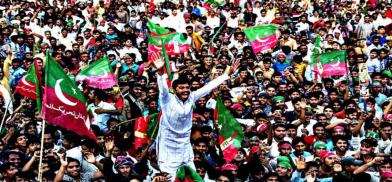Pakistan on the boil: Political instability will impact economic revival
The attention of the current regime in Pakistan will be diverted to firefight for survival and inevitably delays the implementation of crucial reforms to strengthen the economy, writes N Chandra Mohan for South Asia Monitor

At a time when Pakistan’s economy is on the mend and might register marginally positive growth of 0.5 to 1 percent this financial year - after contracting for the first time since the 1950s in 2019-20 - it is being buffeted by winds of political instability. The Pakistan Democratic Movement (PDM), comprising 11 opposition parties; had held its third massive rally in Quetta, the capital of Balochistan. Addressing the rally via video from London, former Prime Minister Nawaz Sharif targeted the army chief and intelligence head for “interfering in politics for several years with impunity in violation of their oaths” by propping up the current PM Imran Khan.
Pakistan stays in FATF's grey list
As if all of this weren’t bad enough, Pakistan continues to be on the grey list of the global terror watchdog, the Financial Action Task Force (FATF), for not doing enough to stamp out the financing of terrorism in the country. Islamabad has time till February 2021 to “swiftly complete” the 27-point action plan in this regard. Islamabad has time till February 2021 to “swiftly complete” the 27-point action plan in this regard.
Islamabad has to implement six items in particular as it has so far ‘largely’ addressed 21 items of this plan to check terror-financing according to FATF. There is no immediate economic fallout of being on a grey list but it seriously imperils continued access to external sources of financing which is critical for Pakistan’s cash–strapped economy.
However, no recovery is possible when political conditions are unstable. The prospect of regime change under near-civil war conditions can undo the ascent green shoots of revival in a trice.
Some cheer
Of late, there has been some evidence of growing cement to fuel sales and demand for home appliances to cars, according to Bloomberg. Higher cement sales clearly point to an uptick in construction activity, a sure sign of brightening economic prospects. Manufacturing output, too, has improved for the second consecutive month in June. A rebound for large-scale manufacturing is expected from October to December with higher global demand.
Pakistan’s policymakers are also buoyed by the first quarterly surplus in goods and services trade with the rest of the world or current account in five years. COVID-19’s initial impact on the economy was through lower exports and remittances from the Diaspora. However, there has been a turnaround in these variables, resulting in a current account surplus of USD 792 million in the first quarter of 2020-21 when compared to a deficit of USD 1,492 million during the same time last year. The big question is whether this surplus is sustainable when costlier imports pick up in line with reviving domestic activity and expatriate Pakistani workers return home.
Economy in crisis
For all these positive signs, the economy is still deep in crisis. The subdued growth prospects this financial year cannot detract from the severe impact all of this has had on the living standards of Pakistani people. The government itself has pegged job losses in the economy due to COVID-19 at a whopping 14 million. In this milieu, poverty is expected to increase for the first time in two decades, according to the World Bank. These adverse distributional outcomes are a potent factor fuelling political opposition. In his video address to the PDM rally at Quetta, former premier Sharif mentioned the current regime “pushing people towards poverty and hunger.”
Besides joblessness, raging inflation has severely eroded the popularity of the current administration in no small measure. Food inflation has been in double digits since August last year, according to the Pakistan Bureau of Statistics. For the first time in the nation’s history, the price of wheat touched PKR 2,400 per 40 kg, with the country staring at shortages of wheat and flour.
Gujranwala, for instance, is a stronghold of PDM and “like most cities in Pakistan hates PM Khan for the rise in food prices, thanks to the government’s incompetence” observed a Pakistani commentator Khaled Ahmed. This problem has been compounded by floods and locust attacks that resulted in considerable crop damage. Costlier food is the most potent cause of popular disaffection and disproportionately affects the unemployed and poor people the hardest.
No doubt, it is true that incipient economic growth can also be upended by a resurgence of viral infection in Pakistan. This will lead to fresh measures to lock down economic activity and shut borders, sending overall growth into a tailspin like in 2019-20. But political instability is not a recipe for sustaining a feeble revival either. The attention of the current regime in Pakistan will be diverted to firefight for survival and inevitably delays the implementation of crucial reforms to strengthen the economy.
The government, for its part, has major plans for the USD 60 billion China-Pakistan Economic Corridor (CPEC), a collection of mega infrastructural projects. One of the earliest CPEC projects is a metro train service that has recently started operations in Lahore.
The ongoing political unrest bids fair to delay the execution of CPEC, impacting growth.
(The writer is an economics and business commentator based in New Delhi. The views expressed are personal. He can be contacted at nchandramohan@rediffmail.com)









Post a Comment